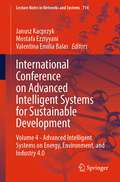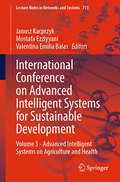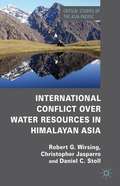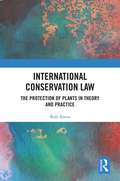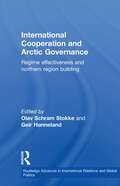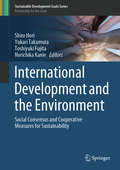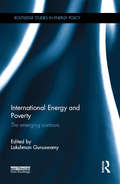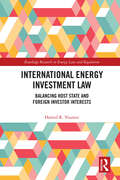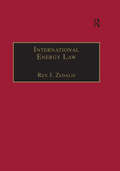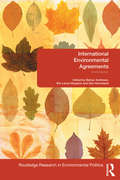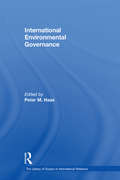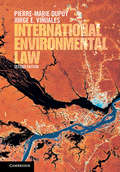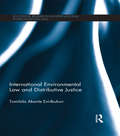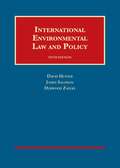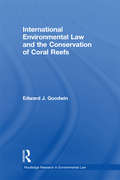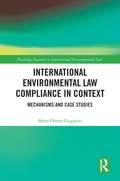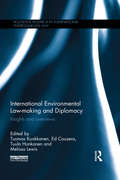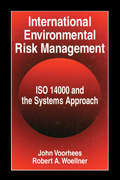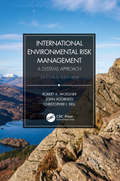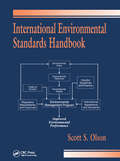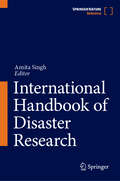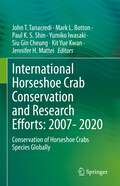- Table View
- List View
International Conference on Advanced Intelligent Systems for Sustainable Development: Volume 1 - Advanced Intelligent Systems on Artificial Intelligence, Software, and Data Science (Lecture Notes in Networks and Systems #637)
by Janusz Kacprzyk Mostafa Ezziyyani Valentina Emilia BalasThis book describes the potential contributions of emerging technologies in different fields as well as the opportunities and challenges related to the integration of these technologies in the socio-economic sector. In this book, many latest technologies are addressed, particularly in the fields of computer science and engineering. The expected scientific papers covered state-of-the-art technologies, theoretical concepts, standards, product implementation, ongoing research projects, and innovative applications of Sustainable Development. This new technology highlights, the guiding principle of innovation for harnessing frontier technologies and taking full profit from the current technological revolution to reduce gaps that hold back truly inclusive and sustainable development. The fundamental and specific topics are Big Data Analytics, Wireless sensors, IoT, Geospatial technology, Engineering and Mechanization, Modeling Tools, Risk analytics, and preventive systems.
International Conference on Advanced Intelligent Systems for Sustainable Development: Volume 4 - Advanced Intelligent Systems on Energy, Environment, and Industry 4.0 (Lecture Notes in Networks and Systems #714)
by Janusz Kacprzyk Mostafa Ezziyyani Valentina Emilia BalasThis book describes the potential contributions of emerging technologies in different fields as well as the opportunities and challenges related to the integration of these technologies in the socio-economic sector. In this book, many latest technologies are addressed, particularly in the fields of computer science and engineering. The expected scientific papers covered state-of-the-art technologies, theoretical concepts, standards, product implementation, ongoing research projects, and innovative applications of Sustainable Development. This new technology highlights, the guiding principle of innovation for harnessing frontier technologies and taking full profit from the current technological revolution to reduce gaps that hold back truly inclusive and sustainable development. The fundamental and specific topics are Big Data Analytics, Wireless sensors, IoT, Geospatial technology, Engineering and Mechanization, Modeling Tools, Risk analytics, and preventive systems.
International Conference on Advanced Intelligent Systems for Sustainable Development: Volume 3 - Advanced Intelligent Systems on Agriculture and Health (Lecture Notes in Networks and Systems #713)
by Janusz Kacprzyk Mostafa Ezziyyani Valentina Emilia BalasThis book describes the potential contributions of emerging technologies in different fields as well as the opportunities and challenges related to the integration of these technologies in the socio-economic sector. In this book, many latest technologies are addressed, particularly in the fields of computer science and engineering. The expected scientific papers covered state-of-the-art technologies, theoretical concepts, standards, product implementation, ongoing research projects, and innovative applications of Sustainable Development. This new technology highlights, the guiding principle of innovation for harnessing frontier technologies and taking full profit from the current technological revolution to reduce gaps that hold back truly inclusive and sustainable development. The fundamental and specific topics are Big Data Analytics, Wireless sensors, IoT, Geospatial technology, Engineering and Mechanization, Modeling Tools, Risk analytics, and preventive systems.
International Conflict over Water Resources in Himalayan Asia
by Robert G. Wirsing Daniel C. Stoll Christopher JasparroThe authors explore the fresh water crisis of Himalayan Asia. While the region hosts some of the world's mightiest rivers, it is also home to rapidly modernizing, increasingly affluent, and demographically multiplying societies, ensuring the rapid depletion of water resources and of disputes over ownership of transboundary waters.
International Conservation Law: The Protection of Plants in Theory and Practice
by Rob AmosThrough a combination of theoretical and empirical approaches, this book explores the role of international environmental law in protecting and conserving plants. Underpinning every ecosystem on the planet, plants provide the most basic requirements: food, shelter and clear air. Yet the world’s plants are in trouble; a fifth of all plant species are at risk of extinction, with thousands more in perpetual decline. In a unique study of international environmental law, this book provides a comprehensive overview of the challenges and restrictions associated with protecting and conserving plants. Through analysing the relationship between conservation law and conservation practice, the book debates whether the two work symbiotically, or if the law poses more of a hindrance than a help. Further discussion of the law’s response to some of the major threats facing plants, notably climate change, international trade and invasive species, grounds the book in conservation literature. Using case studies on key plant biomes to highlight the strengths and weaknesses of the law in practice, the book also includes previously unpublished results of an original empirical study into the correlations between the IUCN Red List and lists of endangered/protected species in international instruments. To conclude, the book looks to the future, considering broader reforms to the law to support the work of conservation practitioners and reshape humanity’s relationships with nature. The book will be of interest to scholars and students working in the field of international environmental law and those interested more broadly in conservation and ecological governance frameworks.
International Cooperation and Arctic Governance: Regime Effectiveness and Northern Region Building (Routledge Advances in International Relations and Global Politics)
by Olav Schram Stokke Geir HønnelandA new exploration of the impacts of Arctic regimes in such vital areas as pollution, biodiversity, indigenous affairs, health and climate change. The post-Cold War era has seen an upsurge in interest in Arctic affairs. With new international regimes targeting Arctic issues at both the global and regional levels, the Northern areas seem set to play an increasingly prominent role in the domestic and foreign policies of the Arctic states and actors – not least Russia, the USA and the EU. This volume clearly distinguishes between three key kinds of impact: effectiveness, defined as mitigation or removal of specific problems addressed by a regime political mobilization, highlighting changes in the pattern of involvement and influence in decision making on Arctic affairs region building, understood as contributions by Arctic institutions to denser interactive or discursive connectedness among the inhabitants of the region. Empirically, the main focus is on three institutions: the Arctic Council, the Barents Euro-Arctic Region and the Council of the Baltic Sea States. International Cooperation and Arctic Governance is essential reading for all students with an interest in Arctic affairs and their impact on global society.
International Development and the Environment: Social Consensus and Cooperative Measures for Sustainability (Sustainable Development Goals Series)
by Shiro Hori Yukari Takamura Toshiyuki Fujita Norichika KanieThis book analyzes the interplay between development and the environment, focusing on how to forge social consensus and practices in the international community. Since the Rio Earth Summit in 1992, sustainable development has increasingly attracted the attention of the international community, and several international agreements have been concluded to combat issues such as climate change. The Sustainable Development Goals (SDGs) were introduced as common objectives, and the Paris Agreement was adopted as a subsequent outcome. In light of today’s globalized world, how to best achieve sustainable development—and prioritize climate change in particular—is an issue involving various perspectives on the environment and economic development in the global community.The book provides students, businesspeople and government officials with a concept of sustainable development that is based on using social consensus, social norms, and practices (cooperative global actions) to achieve common goals. It is divided into three parts, the first of which focuses on the goals and development needed to achieve sustainable development. The second part explores measures to promote sustainable development, while the third highlights current climate change issues and aspects related to the effective implementation of international frameworks.
International Energy and Poverty: The emerging contours (Routledge Studies in Energy Policy)
by Lakshman GuruswamyAround 2.8 billion people globally, also known as the "Other Third" or "energy poor", have little or no access to beneficial energy that meets their needs for cooking, heating, water, sanitation, illumination, transportation, or basic mechanical power. This book uniquely integrates the hitherto segmented and fragmented approaches to the challenge of access to energy. It provides theoretical, philosophical and practical analysis of energy for the low energy (non-hydrocarbon based) Other Third of the world, and how the unmet needs of the energy poor might be satisfied. It comprehensively addresses the range of issues relating to energy justice and energy access for all, including affordable - sustainable energy technologies (ASETs). The book breaks new ground by crafting a unified and cohesive framework for analysis and action that explains the factual and socio-political phenomenon of the energy poor, and demonstrates why clean energy is a primary determinant of their human progress. This is a must-read for all scholars, students, professionals and policy makers working on energy policy, poverty, and sustainable energy technologies.
International Energy Investment Law: Balancing Host State and Foreign Investor Interests (Routledge Research in Energy Law and Regulation)
by Hamid R. YounesiThis book analyses relational contract theory within the context of international energy investment agreements.Putting forth an exhaustive assessment of the field, the book provides a pragmatic resolution to the challenges inherent in the relationship between host states and foreign investors. Addressing critical queries confronting legal practitioners, arbitrators, judges, and scholars grappling with contractual imbalances, including the looming threat of expropriation, the book offers comprehensive insights. Balancing the interests of both host states and investors, the volume discusses global case studies which have proven to be efficacious and proposes a solution grounded in existing legal doctrines and practices.The book will be of interest to researchers in the field of energy law, international investment law, and contract theory and law.
International Energy Law: Rules Governing Future Exploration, Exploitation and Use of Renewable Resources
by Rex J. ZedalisThe international legal rules affecting renewable alternative energy resources are amongst the most important legal and environmental concerns of the near future. As traditional energy sources are depleted, new technologies are being developed to harness the potentials of wave, current and tidal energy, coastal wind power, offshore geothermal, polar energy resources and space-based solar collection. This book is the first comprehensive analysis of the legal rules governing the alternative energy resource potential of all international common areas - the high seas, the polar zones (especially Antarctica) and outer space. In a detailed, but precisely analyzed text, the book also reviews the international environmental rules affecting exploration, exploitation and use of internationally situated energy resources, alongside resources located offshore under national jurisdictions. This is accompanied by a critical look at the connection between efforts to control greenhouse gases and the growing interest in non-polluting alternatives found in the international "commons . The result is a work of unprecedented value for environmental and international law academics and practitioners, as well as those interested in environmental resource economics and politics.
International Environmental Agreements: An Introduction (Environmental Politics)
by Steinar Andresen Geir Hønneland Elin Lerum BoassonInternational environmental agreements provide a practical basis for countries to address environmental issues on a global scale. This book explores the workings and outcomes of these agreements, and analyses key questions of why some problems are dealt with successfully and others ignored. By examining fundamental policies and issues in environmental protection this text gives an easily comprehensible introduction to international environmental agreements, and discusses problems in three areas: air, water and on land. It traces the history of agreements in broad thematic areas related to long-distance air pollution, ozone-depleting and greenhouse gases, ocean management, biological diversity, agricultural plant diversity and forest stewardship. Drawing on experts in their respective fields, this book provides an insightful evaluation of the successes and failures, and analysis of the reasons for this. Concluding with an insightful examination of research to show how performance of agreements can be improved in the future, this volume is a vital contribution to our understanding of the politics associated with establishing international environmental consensus. International Environmental Agreements will be of interest to scholars, students and researchers in global environmental politics, international relations and political science. Steinar Andresen is Senior Research Fellow at the Fridtjof Nansen Institute, Norway, and formerly professor at the Dept. of Political Science, University of Oslo. Elin Lerum Boasson is Research Fellow at the Fridtjof Nansen Institute, Norway. Geir Hønneland is Research Director at the Fridtjof Nansen Institute and adjunct professor at the University of Tromsø.
International Environmental Governance (The\library Of Essays In International Relations Ser.)
by Peter M. HaasInternational Environmental Governance reviews the contentious approaches to addressing global and transboundary environmental threats. The volume collects together the most influential and important literature on the major political approaches to dealing with these problems, their histories, major debates, and research frontiers. It is accompanied by a substantial introduction which reviews the evolution of the academic contribution to environmental governance, focusing on a wide array of international environmental problems.
International Environmental Law
by Dupuy, Pierre-Marie and Viñuales, Jorge E. Pierre-Marie Dupuy Jorge E. ViñualesThis textbook provides a concise, conceptually clear, and legally rigorous introduction to contemporary international environmental law and practice. Written in an accessible style, the book covers all the major multilateral environmental agreements, paying particular attention to their underlying structure, their main legal provisions, and their practical operation. The material is structured into four sections: (I) Foundations, (II) Substantive regulation, (III) Implementation, and (IV) International environmental law as a perspective. The presentation of the material blends policy and legal analysis and makes extensive reference to the relevant treaties, instruments and jurisprudence. All chapters include a detailed bibliography along with numerous figures to summarise the main components of the regulation. It covers emerging topics such as foreign investment and the environment, environmental migration, climate change and human rights, technology diffusion, and environmental security in post-conflict settings.
International Environmental Law: An Introduction
by Pierre-Marie Dupuy Jorge E. ViñualesInternational Environmental Law offers a concise, conceptually clear, and legally rigorous introduction to contemporary international environmental law and practice. The book covers all major environmental agreements, paying particular attention to their underlying structure, main legal provisions, and practical operation. It blends legal and policy analysis, making extensive reference to the jurisprudence and scholarship, and addressing the interconnections with other areas of international law, including human rights, humanitarian law, trade and foreign investment. The material is structured into four sections - foundations, substantive regulation, implementation, and influence on other areas of international law - which help the reader to navigate the different areas of international environmental law. Each chapter includes charts summarising the main components of the relevant legal frameworks and provides a detailed bibliography. Suitable for practicing and academic international lawyers who want an accessible, up-to-date introduction to contemporary international environmental law, as well as non-lawyers seeking a concise and clear understanding of the subject.
International Environmental Law and Distributive Justice: The Equitable Distribution of CDM Projects under the Kyoto Protocol (Routledge Research in International Environmental Law)
by Tomilola Akanle Eni-IbukunThe Clean Development Mechanism (CDM) is widely regarded as one of the Kyoto Protocol’s best creations and as an essential part of the international climate change regime. The CDM has been constantly evolving to ensure that it fulfils its objectives of mitigating climate change and contributing to sustainable development in developing countries. The over 6,000 registered projects under the CDM are estimated to have generated almost US$200 billion of investment in developing countries and are expected to achieve GHG emission reductions of about 6.8 billion tonnes. Nevertheless, the CDM is not perfect, and one of its main problems is the inequitable geographic distribution of projects among developing countries. Understandably, this is a problem that countries are very keen to address, and since 2001, even before the first project was registered, countries have been highlighting the need to ensure that projects are equitably distributed among participating countries. This book looks at distributive justice under the CDM regime and focuses on the issue of equity in the geographic distribution of CDM projects among developing countries. The book investigates relevant aspects of international law to identify the legal characteristics of equitable distribution or distributive justice, in order to establish what equitable distribution in the CDM should look like. Based on these investigations, Tomilola Akanle Eni-Ibukun breaks new ground in defining equitable distribution under the CDM and exploring how key obstructions to the equitable distribution of projects may be overcome. The book will be of particular interest to academics and policymakers of climate change and the CDM within international law.
International Environmental Law And Policy (University Casebook)
by David Hunter James Salzman Durwood ZaelkeThe most widely adopted text in the field, this comprehensive, multidisciplinary casebook analyzes all aspects of international environmental law and policy, including the major environmental treaty regimes, customary law principles and the development and evolution of soft law norms. It emphasizes the dynamic nature of the law-making process, including global environmental diplomacy and the critical role of non-state actors, including scientists, NGOs, and business. It presents the binding norms of international environmental law, and explains how international cooperation facilitates and strengthens global environmental governance through setting national priorities, coordinating bilateral and multilateral science, financing, technology sharing, and capacity building.
International Environmental Law and the Conservation of Coral Reefs (Routledge Research in International Environmental Law)
by Edward J. GoodwinTropical coral reefs are important ecosystems. They are economically important to coastal communities living in predominantly developing countries, and also provide shoreline protection, catalyse land formation enabling human habitation, act as a carbon sink and are a repository for genetic and species diversity rivalling rainforests. In the face of mounting man-made pressure from pollution, climate change and over-exploitation, these ecosystems increasingly need action to be taken to ensure their conservation and long term sustainable development. International Environmental Law and the Conservation of Coral Reefs breaks new ground by providing the first in-depth account of the ways in which multilateral environmental treaty regimes are seeking to encourage and improve the conservation of tropical coral reef ecosystems. In so doing, the work aims to raise the profile of such activities in order to reinforce their status on the environmental agenda. The book also has wider implications for international environmental law, arguing that sectorial legal action, provided it remains co-ordinated through a global forum that recognises and reflects the inter-connections between all elements of the natural environment, is the most effective way for international law to enhance the conservation of certain habitats. This book will be invaluable to environmental lawyers, legal researchers, marine conservationists and other stakeholders in coral reefs.
International Environmental Law and the Global South
by Alam, Shawkat and Atapattu, Sumudu and Gonzalez, Carmen G. and Razzaque, Jona Shawkat Alam Sumudu Atapattu Carmen G. Gonzalez Jona RazzaqueThe unprecedented degradation of the planet's vital ecosystems is among the most pressing issues confronting the international community. Despite the proliferation of legal instruments to combat environmental problems, conflicts between rich and poor nations (the North-South divide) have compromised international environmental law, leading to deadlocks in environmental treaty negotiations and noncompliance with existing agreements. This volume examines both the historical origins of the North-South divide in European colonialism as well as its contemporary manifestations in a range of issues including food justice, energy justice, indigenous rights, trade, investment, extractive industries, human rights, land grabs, hazardous waste, and climate change. Born out of the recognition that global inequality and profligate consumerism present threats to a sustainable planet, this book makes a unique contribution to international environmental law by emphasizing the priorities and perspectives of the global South.
International Environmental Law Compliance in Context: Mechanisms and Case Studies (Routledge Research in International Environmental Law)
by Belen Olmos GiupponiThis book explores how compliance with international environmental law has changed over time, offering a critical analysis of its current shifting patterns. Beginning with an overview of compliance with international environmental law, the book goes on to explore in detail: compliance in the different legal regimes instituted by Multilateral Environmental Agreements (MEAs), the addition of new subjects of international law, the legal relations between developed and developing countries, and the emergence of new compliance mechanisms in global environmental law. The analysis takes two key developments into consideration: the evolution in forms of compliance and non-state involvement in compliance with international environmental law. In the final section, three case studies are provided to demonstrate how these changes have occurred in selected areas: climate change, biodiversity and water resources. Throughout the book, topics are illustrated with extracts from specific international environmental law jurisprudence and relevant international environmental law instruments. In doing so, the book offers a comprehensive analysis of compliance with international environmental law, providing original insights and following a clear and systematic structure supported by reference to the sources. This book will be of interest to professionals, academics and students working in the field of compliance with international environmental law.
International Environmental Law-making and Diplomacy: Insights and Overviews (Routledge Research in International Environmental Law)
by Tuomas Kuokkanen Ed Couzens Tuula Honkonen Melissa LewisBringing together contributions from diplomats, UN agency officials, lawyers and academics, this book provides insight into the evolution of international environmental law, diplomacy and negotiating techniques. Based on first-hand experiences and extensive research, the chapters offer a blend of practice and theory, history and analysis, presenting a range of historical episodes and nuances and drawing lessons for future improvements to the processes of law-making and diplomacy. The book represents a synthesis of the most important messages to emerge from the annual course on Multilateral Environmental Agreements, delivered to diplomats and negotiators from around the world for the last decade by the University of Eastern Finland and the United Nations Environment Programme. The book will be of interest as a guide for negotiators and as a supplementary textbook and a reference volume for a wide range of students of law and environmental issues.
International Environmental Risk Management: ISO 14000 and the Systems Approach
by John Voorhees Robert A. WoellnerInternational Environmental Risk Management: ISO 14000 and the Systems Approach gives readers an extensive analysis of practical applications of ISO 14000 and environmental compliance management systems. It offers a mixture of technical engineering advice, legal guidance, and common-sense business acumen. The authors explain the essentials of the standards - how they are being developed and what implications they present - and then discuss cost-benefit analyses, integration strategies, business risk control measures, litigation avoidance and legal expense reduction, and step-by-step guidance on achieving third-party certification.
International Environmental Risk Management: A Systems Approach
by Robert A. Woellner John Voorhees Christopher L. BellBased on the first edition with extensive analysis of practical applications of environmental risk management and compliance management systems, this second edition of International Environmental Risk Management reflects updates made in the understanding and application of risk management best practices and makes available a frame of reference and systematic approach to environmental and social governance (ESG). It provides a pathway for readers to implement environmental management strategies that can be integrated with core operations and other risk management efforts, including supporting sustainability and corporate social responsibility initiatives associated with climate change, the circular economy or supply chain conditions, as well as enterprise risk management; anti-bribery, and other compliance management systems. This book provides in-depth discussions of ways to use global environmental management standards. New features in this edition: Combines EMS standards with discussion of specific principles, other authors’ research, and guidelines on management practices. Provides guidelines on how to prepare for, anticipate, and resolve environmental issues. Includes easily understandable information for all readers and is not simply aimed toward individuals who are knowledgeable about this topic. Provides in-depth discussions on using global environmental management standards to manage risk and promote resilience, as well as legal strategies and voluntary initiatives that companies can utilize to minimize risk. Accounts for the substantive revisions in ISO 14001:2015. As a growing and rapidly changing field, it is necessary to address new issues, guidelines, and regulations to assist businesses, academia, students, consultants, lawyers, and environmental managers with a pragmatic resolution to environmental risk management issues. This second edition gives a broad and detailed analysis of the changes made to international standards and practices and serves as an excellent guide to managing environmental risk.
International Environmental Standards Handbook
by Scott S. OlsonLack of knowledge about, and noncompliance with, international standards can result in loss of sales and partnership opportunities as well as possible legal action. The International Environmental Standards Handbook provides the necessary historical background to understand the current status of international environmental standards. It contains copies of available treaties and provides coverage of laws and standards. The book offers strategies for designing and implementing environmental systems that will be internationally accepted. It includes a list of information sources and a directory of international environmental organizations.
International Handbook of Disaster Research
by Amita SinghThis handbook is a comprehensive source of information, analysis and directions in disaster studies. It goes beyond the oft-explored issues of management and science related to the topic and explores policies, governance, law and decision-making combined with the processes of implementation and enforcement, all the while integrating the latest science and technology updates related to the topic, such as artificial intelligence and early warning systems. It brings together studies which relate to sociology, politics and institutional economics, which work under the impact of resource availability, issues of leadership and international laws. Disasters are trans-boundary and disaster studies are trans-disciplinary. It is this aspect which would form the fulcrum of contributions and present a new, refreshing and innovative design for the handbook. The transformatory pedagogy which started with the Hyogo Framework for action 2005-2015 and The Sendai Framework for Disaster Risk Reduction 2015-2030 outlines seven clear targets and four priorities for action to prevent new and reduce existing disaster risks. The four priority areas around which the book would revolve are (i) Understanding disaster risk; (ii) Strengthening disaster risk governance to manage disaster risk; (iii) Investing in disaster reduction for resilience and; (iv) Enhancing disaster preparedness for effective response, and to "Build Back Better" in recovery, rehabilitation and reconstruction.
International Horseshoe Crab Conservation and Research Efforts: Conservation of Horseshoe Crabs Species Globally
by John T. Tanacredi Mark L. Botton Paul K. S. Shin Yumiko Iwasaki Siu Gin Cheung Kit Yue Kwan Jennifer H. MatteiThe first International Conference on Horseshoe Crab’s Conservation conducted at Dowling College, USA, (2007) and it’s proceedings published by Springer in 2009, prompted the continued research and conservation efforts presented at subsequent conferences and colloquium in Hong Kong, Taiwan, (2011); San Diego, CA, (2014), (CERF); Japan, Sasebo (2015) and an accepted inclusion for a special session on Horseshoe Crabs at the 2017 CERF Conference held in Providence, RI, USA. All these aforementioned conferences contributed manuscripts, posters, workshop “position papers”, and oral presentations the majority of which have not been published in total. In 2015, Carmichael et al. had published by Springer the majority of manuscripts from the 2011 Hong Kong / Taiwan conference. However, workshop results and all subsequent presentations and workshops were not. The Japan conference presented over 40 papers alone. A collection of all workshop summaries, poster presentations and new manuscript submittals (San Diego, CA; Sasebo, Japan; and Providence, RI) as well as products prepared for the IUCN World Congress in Hawaii, (2016), are included potential contributions for review in this compilation now available for global distribution in this Springer Nature publication.The “Proceedings of International Conferences on the Biology and Conservation of Horseshoe Crabs”, thus contains over 50 manuscripts and a diversified collection of documents, photos and memorabilia covering all four of the horseshoe crab species globally: their biology, ecology evolution, educational, and societal importance. This book exposes the impacts that humans have imposed on all four of these species, revealing through the coordinated effort of horseshoe crab scientists with the IUCN, of the worldwide need for a clear conservative effort to protect these paleo- survival organisms from a looming extinction event. Biologists, conservationists, educators, and health professionals will all welcome this book not only for exploration of its pharmacological interest, but also for the mystery of their longevity. This book also clarifies the future research needs and the conservation agenda for the species worldwide. Anyone working or studying estuaries on a global scale, will need to obtain this seminal work on horseshoe crabs.

